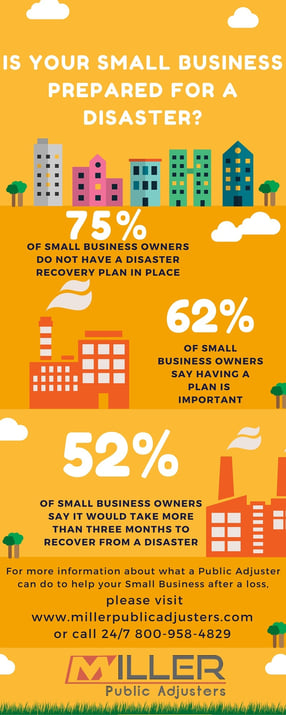
As a professional in the industry, Miller Public Adjusters has seen the impact of natural disasters to businesses and consumers alike. While it’s been quite some time since we’ve seen a catastrophic event in our area, we all need to be aware of the consequences damaging spring storms in our area can have.
Nationwide commissioned Harris Poll to conduct their second annual survey in June 2015 among 500 U.S. small-business owners who have fewer than 300 employees and at least a moderate role in employee benefit selection.
Their survey found that:
- Small-business owners are split on whether climate change has increased (41%) or decreased (35%) the chance of a disaster affecting their company
- While owners are divided on the impact of climate change and El Nino on their companies, half (51%) said some people would call them a “prepper”
- The vast majority still don’t have a disaster plan in place (75%) or Business Interruption Insurance (66 percent)
(source)
While shocking, we’re not surprised to learn that many still don’t have a disaster plan or business interruption insurance.
Here are seven steps you can take to prepare your small business for a disaster courtesy of disastersafety.org & Property Casualty 360:
- Know your risks: Determine the greatest threats to your business, the likelihood or probability for each of those threats, how severe each event could be, and the potential effect on each business function or process.
- Understand your operations: Decide the maximum amount of time you can endure being closed after a disaster occurs by identifying your key business functions and processes, and then determine how long you can go without being able to perform them
- Reach your employees: Your employees are your most valuable asset, so make sure you know how to reach them during an emergency; have your employees review and update their contact information at least every six months, and create a special emergency email account.
- Contact your customers: Identify various ways to communicate with key customers, contacts, suppliers and vendors after a disaster, such as direct telephone calls, texts, emails, social media posts or announcements on your company website.
- Prepare your technology: Keep a backup copy of your computers’ operating systems, boot files, critical software and operations manuals; maintain an updated copy of computer and Internet login codes and passwords.
- Evaluate your insurance: Understand your insurance policies and meet regularly with your agent or broker to make sure you understand your coverage, deductible, limits and claim filing process; consider a small business insurance policy that will reimburse you for business interruptions in addition to physical losses.
Update your plan: For your plan to be successful when a disruption occurs, you must maintain and update it on a regular basis; keep your employees informed of any changes as this will help when they need to put the disaster recovery plan into action.
Miller Public Adjusters currently serves the states of
Wisconsin - Florida - Illinois - Indiana - Michigan - Minnesota - Texas
Call us 24 hours a day at (800)958-4829 to schedule an appointment or
please fill out a Free Claim Review to see if we can help.
.png?width=190&height=55&name=MPA%20Logo%20Vector%20-%20Original%20(3).png)


.webp?width=331&height=382&name=ResourcesCTA-Fin-001%20(1).webp)



